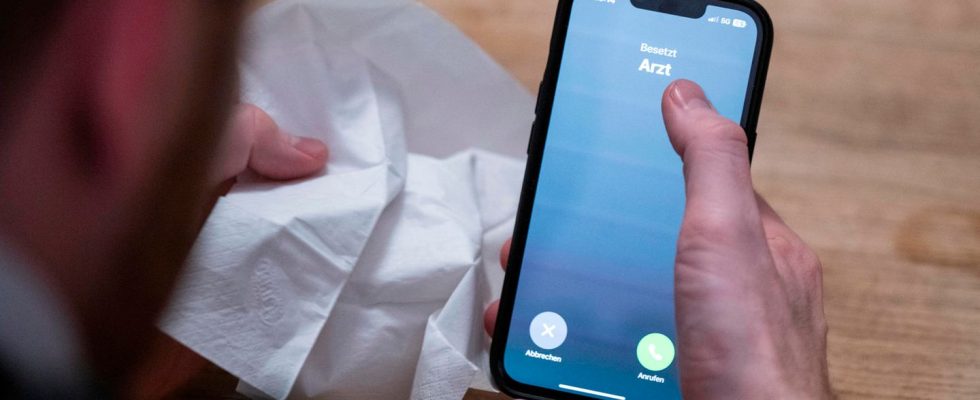Wave of infections
Sick leave by telephone is possible again – what you should know about it
From Thursday it will be possible to get a sick note again by telephone if you have mild symptoms
© Hannes P. Albert / DPA
There is currently coughing and sniffling everywhere in the family doctor’s waiting rooms. Anyone who only has mild symptoms and is already known to the practice will be allowed to call in sick in the future. We explain how exactly this works.
Many doctors welcome telephone sick notes as a relief. But: How many people currently have a cold and go to the doctor because of it?
The Robert Koch Institute estimates that more than seven million people currently suffer from a respiratory infection. The most important pathogens are rhinoviruses and SARS-CoV-2. However, the number of severe respiratory diseases caused by the RS virus is also increasing, especially among children under four years of age.
On the other hand, around 2,000 out of 100,000 people go to the doctor every week because of respiratory infections. This corresponds to a total of around 1.7 million doctor visits.
Who can request sick leave over the phone?
The Federal Committee announced that the regulation will apply from Thursday. Accordingly, the prerequisites are that video consultations are not possible and that patients are already known to the respective family doctor’s practice. In addition, those affected must not have any severe symptoms.
Why can you no longer get sick leave for seven days over the phone?
At the committee meeting, the umbrella association of statutory health insurance companies (GKV) spoke out against seven-day sick leave. Her representative argued that the opportunities for doctors to assess the illness over the telephone were significantly reduced. Ultimately, it is about issuing a document that must have reliable evidentiary value to the employer.
Doctors’ representatives, on the other hand, advocated a uniform regulation for tele-sick notes. They pointed out that this was already possible for seven days with the existing video sick note.
How often do Germans take sick leave?
Current data is available from the Techniker Krankenkasse, for example. Statistically speaking, every employed person there was on sick leave for around 9.5 days in the first half of 2023 – a new high. In the first half of 2022 there was an average of 9.1 days. In previous years, the values for the first half of the year were significantly lower (2021: 6.8 days of absence; 2020: 8.0; 2019: 7.8). There are similar figures from other health insurance companies. Experts believe that the reason for the increasing number of days of absence is, among other things, increased sensitivity among employees. They may be staying at home today so as not to infect their colleagues.
What are the most common diagnoses?
The main reason for sick leave is flu and colds such as a runny nose and bronchitis. On average, they accounted for 2.5 of the TC sick days. In second place in the first half of 2023 were sick notes due to psychological diagnoses – with an average of 1.74 days missed per person. Musculoskeletal disorders such as back pain accounted for 1.36 days of absence.
7 images
How are telephone sick notes received by the population?
It’s not just doctors who are positive about the possibility. The opinion research institute Yougov surveyed 3,755 people aged 18 and over on November 29th. Result: Around two thirds (67 percent) would tend to be in favor of telephone sick notes. A good 34 percent would be “completely” in favor of it, another 33 percent would be “somewhat” in favor of it. Only around 20 percent said they would somewhat or completely reject the option.
Sources: RKI weekly report, Yougov survey, Communication from technician health insurance companywith material from AFP


